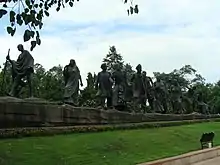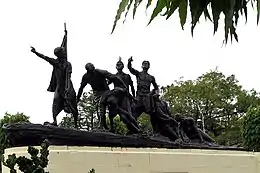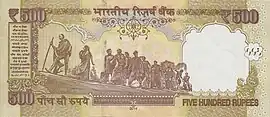Gyarah Murti
Gyarah Murti is a monument located in New Delhi, India, commemorating the country's struggle for independence under the leadership of Mahatma Gandhi. Devi Prasad Roy Choudhury is credited as its sculptor. An ensemble of eleven statues, ten represent people from diverse sociocultural, religious and economic backgrounds following Gandhi in the lead. Widely believed to depict the Dandi March, the statue has been replicated in other cities in India and was featured on the old 500-rupee currency note.[1][2]

Location
The statue is located near the President's Estate, New Delhi, at the T-junction where Sardar Patel Marg meets Mother Teresa Crescent.[3][4][5] The statue is approached through Sardar Patel Marg and the entire locality is known as Gyarah Murti.[6]

Sculptor
Devi Prasad Roy Choudhury is credited as the creator of the statue which was commissioned by the Government of India in 1972 as a national monument to commemorate the silver jubilee of Indian independence.[7][8][9] It bears semblance to the Martyr's Memorial in Patna, which was completed by Choudhury in 1959, and features six figures following a flag bearer while urging on those who have fallen. The Martyr's Memorial in Patna commemorates the sacrifices made by ordinary Indians in their struggle for freedom from British rule.

Design
The statue features at its head Mahatma Gandhi who is followed by ten other persons who include a woman with a sari draped over her head, a group of three men – a Hindu, a Sikh and a Muslim, a turbaned man, an emaciated man, a Christian priest, a woman and a young man urging a tired old man to join the group.[10] The statues are bronze cast and have a height of 8 feet (2.4 m), and the entire installation is 26 metres (85 ft) long and 3 metres (9.8 ft) tall.[11][12]
It is commonly believed that the statue represents Gandhi's march to Dandi and that certain figures have been modelled on Matangini Hazra, Sarojini Naidu, Brahmabandhab Upadhyay and Abbas Tyabji.[13][14] However, both these assumptions have been disputed. It has been contended that the statue is not a representation of the Salt March as were no women among the group of satyagrahis who accompanied Gandhi on this march.[15] The plaque at the statue states that it was built "In memory of the countless Indians who, generation after generation, struggled and sacrificed against foreign rule. Mahatma Gandhi's leadership of the Indian National Congress finally won independence and Jawaharlal Nehru became the first Prime Minister of free India on 15 August 1947."[16] As is the case in Choudhary's other works, the figures that constitute the Gyarah Murti, with the exception of Gandhi, are not persons of eminence but represent common people drawn from various classes and communities of India united in the common cause of seeking India's independence.[17] The statue is one of Delhi's best-known examples of public art.[18][19]
Replicas and other depictions

Who Deviated First?, a digital print on archival paper by the artist Gigi Scaria, is a morphed photograph of the Gyarah Murti where the statues following Gandhi have been turned around and appear to walk in the opposite direction.[20][21] The 2010 work is a comment on India's divergence from Gandhi's ideals and its growing communal and caste violence.[22][23] A replica of the Gyarah Murti was installed in Mysore, Karnataka, in 2011, whereas the copy built in 2015 in Godhra in Gujarat met with controversy when it emerged that it had only nine followers instead of ten as in the original. Following widespread criticism, the municipal authorities were forced to fix the error.[24][25][26][27][28] Gyarah Murti featured on a 2010 postage stamp issued by Togo.[29] It also featured on a 2019 postage stamp released by India Post as part of a series on Gandhian heritage in Modern India to commemorate the 150th birthday of Mahatma Gandhi.[30] India's 500-rupee currency note featured the statue on its reverse side.[31]
Controversies
In 1999 the round spectacles on Gandhi's statue were stolen, and the statue has since remained without them. The thief was never caught, and the theft has remained unresolved.[32][33]
References
- "This Gandhi Jayanti, we follow trail of the Mahatma's statues in Delhi NCR". Hindustan Times. 1 October 2016. Retrieved 18 July 2022.
- "Glimpses of Gandhi: Places you can visit". Hindustan Times. 2 October 2019. Retrieved 18 July 2022.
- Brown, Judith; Parel, Anthony (21 February 2011). The Cambridge Companion to Gandhi. Cambridge University Press. p. 213. ISBN 978-1-139-82484-2. Retrieved 18 July 2022.
- Das, Arpita (6 April 2019). "The women who heeded Gandhi's call". mint. Retrieved 18 July 2022.
- "Mahatma Gandhi's legacy looms large over Rashtrapati Bhavan". The Indian Express. 4 October 2020. Retrieved 18 July 2022.
- "Delhi's missing public art". The Indian Express. 27 March 2009. Retrieved 18 July 2022.
- "Govt plan for Independence jubilee". The Hindu. 19 July 2022. Retrieved 25 July 2022.
- Nainy, Mamta (23 March 2018). A Brush with Indian Art. Penguin Random House India Private Limited. p. 109. ISBN 978-93-5305-171-6. Retrieved 18 July 2022.
- "October 16, Forty Years Ago: Sculptor Dead". The Indian Express. 16 October 2015. Retrieved 18 July 2022.
- "Here's All About Gyarah Murti, A Massive & Glistening Black Sculpture In The Heart Of The City". So City. 12 March 2022. Retrieved 18 July 2022.
- "Public Art: Sculptures by Deviprasad Roy Chowdhury capture key moments in Indian History". The Heritage Lab. 17 June 2021. Retrieved 18 July 2022.
- Milton, Lawrence; Aug 10, H. M. Aravind / TNN / Updated. "I-Day gift: Bringing alive Dandi March". The Times of India. Retrieved 18 July 2022.
- Das, Arpita (6 April 2019). "The women who heeded Gandhi's call". mint. Retrieved 18 July 2022.
- "Public Art: Sculptures by Deviprasad Roy Chowdhury capture key moments in Indian History". The Heritage Lab. 17 June 2021. Retrieved 18 July 2022.
- Reading, A.; Katriel, T. (9 June 2015). Cultural Memories of Nonviolent Struggles: Powerful Times. Springer. pp. 41–43. ISBN 978-1-137-03272-0. Retrieved 18 July 2022.
- Reading, A.; Katriel, T. (9 June 2015). Cultural Memories of Nonviolent Struggles: Powerful Times. Springer. pp. 41–43. ISBN 978-1-137-03272-0. Retrieved 18 July 2022.
- Kurian, Annly Anna (30 March 2021). "Statues of New Delhi". Dhaara. Retrieved 18 July 2022.
- "Delhi's missing public art". The Indian Express. 27 March 2009. Retrieved 18 July 2022.
- Kumar, Meenakshi (10 October 2010). "Public art needs a start". The Times of India. Retrieved 18 July 2022.
- "Artists across generations have painted the Mahatma". The Indian Express. 2 October 2021. Retrieved 18 July 2022.
- "Bapu as a muse". The Pioneer. Retrieved 18 July 2022.
- Reading, A.; Katriel, T. (9 June 2015). Cultural Memories of Nonviolent Struggles: Powerful Times. Springer. pp. 41–43. ISBN 978-1-137-03272-0. Retrieved 18 July 2022.
- "A look at Mahatma Gandhi through the eyes of artists". Architectural Digest India. Condé Nast. 2 October 2019. Retrieved 18 July 2022.
- "Replica of 'Gyarah Moorti' unveiled in city". Deccan Herald. 15 August 2011. Retrieved 18 July 2022.
- Milton, Lawrence; Aug 10, H. M. Aravind / TNN / Updated. "I-Day gift: Bringing alive Dandi March". The Times of India. Retrieved 18 July 2022.
- "Godhra's 'Gyarah Murti' minus one, to be replaced". The Indian Express. 7 July 2016. Retrieved 18 July 2022.
- "Godhra municipality begins work to fix Gyarah Murti mural". The Times of India. 29 July 2016. Retrieved 18 July 2022.
- "Missing 'Gyarah Murti' figure: Godhra Municipality begins work to modify Dandi march sculpture". The Indian Express. 30 July 2016. Retrieved 18 July 2022.
- R, Lavanya. Life of Mahatma Gandhi through Philately: Gandhi Stamp Catalogue. Catabooks. p. 460. ISBN 978-93-5473-554-7.
- "Postage Stamps Highlight Gandhian Heritage in Modern India". Mintage World. 20 August 2019. Retrieved 18 July 2022.
- "Iconic sculpture in the heart of Delhi". Azadi Ka Amrit Mahotsav. Ministry of Culture, Government of India. Retrieved 18 July 2022.
- "What makes this Gandhi statue in Luxembourg a rare find". The Week. Retrieved 18 July 2022.
- "Gandhi statue without glasses 18 years after theft". Hindustan Times. 1 October 2018. Retrieved 18 July 2022.